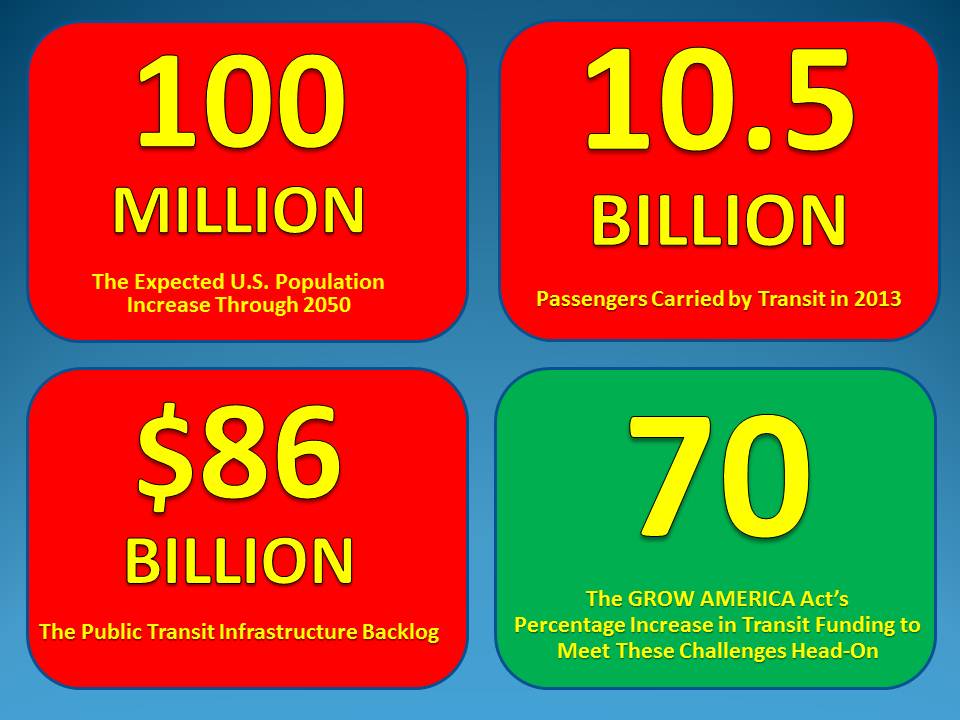Making Critical Investments in Public Transportation
The GROW AMERICA Act will prioritize public transit, recognizing its leading role in providing access to jobs and opportunity for millions of Americans, spurring economic development in communities across the country and reducing carbon emissions while making the air we breathe cleaner. Public transportation carried more than 10.5 billion passengers in 2013. Every day, transit takes people to work, school, medical appointments, grocery shopping, and to countless special events—providing a lifeline to those who do not want or cannot afford a car. Public transit offers a valuable alternative for those seeking to reduce demands on their family budget – or to reduce time lost sitting in congestion.
As the nation’s population and transit ridership continue to rise, so too does the strain on our public transportation infrastructure. The GROW AMERICA Act will provide a strong investment in our public transportation network – not just in our cities and suburbs, but in rural communities too – to ensure that it is safe, reliable, and accessible.

The GROW AMERICA Act will commit more than $115 billion over six years to address the urgent transit challenges facing urban, suburban and rural communities. The GROW America Act represents a 76 percent increase in authorized funding over the prior transportation law, MAP-21. This bold vision is needed to keep America’s economy growing and creating jobs, to help us remain competitive with the rest of the world, and to create a brighter future for generations to come.
“We have a very old system, some of which has operated far beyond its useful life. We have an extensive list of needs and many projects ready to begin, but cannot proceed with the work without adequate funding.”
- Joe Casey, General Manager, Southeastern Pennsylvania Transportation Authority (SEPTA)
The GROW AMERICA Act proposes a powerful, $5.1 billion increase in Fix-it-First investments to address public transit’s maintenance backlog. Unless these needs are addressed, the transit riding public could experience more bus and rail system breakdowns; less reliable service; increased safety risks; and delays making it harder for all commuters to get to work.
- Public transit faces an $86 billion backlog in critical infrastructure maintenance and repair needs – a backlog that increases by an estimated $2.5 billion each year as bus and rail infrastructure continues to age.
As the U.S. population continues growing, both highway congestion and air quality in rapidly growing regions are at risk of getting worse. By the year 2050, the U.S. population is expected to grow by more than 100 million people, further straining public transportation infrastructure and putting pressure on the fastest-growing communities ill-equipped to accommodate such growth.
- The Grow America Act proposes the Rapid Growth Area Transit Program, an innovative, six-year $3.4 billion investment that would help fast growing communities invest in bus rapid transit and other multimodal solutions to get ahead of the challenges caused by rapid growth.
Public transportation supports nearly two million jobs across the country. The transit industry is an economic engine that keeps Americans at work and domestic manufacturing buzzing.
- An estimated 13,000 jobs are supported by every $1 billion invested in public infrastructure.
- In 2013, U.S. transit systems operated approximately 128,500 transit vehicles and 12,746 miles of track, and 149 lane miles of bus rapid transit and served 5,017 rail and bus stations – with the fingerprint of the American workforce on almost all of it because of stringent domestic manufacturing requirements.
- Transformational transportation projects attract economic development in rural and urban communities. For example, the Dallas region is home to more miles of light rail than any other city in North America and has attracted more than $7 billion in economic activity. In the Phoenix area, transit has spurred more than $7 billion in economic activity, while the first rural bus rapid transit line in the U.S. - the VelociRFTA in Colorado’s Roaring Fork Valley – has accelerated the development of new hotel and office space.
- According to a study by the National Association of Realtors and the American Public Transportation Association (APTA), during the last recession, residential property values performed nearly 42 percent better on average when located near high-frequency public transportation.
“I believe that mass transit is a necessary investment and a core function of federal, state and local governments. Managed properly, mass transit investment is a very wise use of public money as it will reduce the need for expensive roads and highways, increase mobility, promote economic growth and commerce and improve air quality and the quality of life in communities that adopt transit systems.”
- Greg Hughes, Chairman of the Board of Trustees for the Utah Transit Authority; House Republican Majority Whip, Utah House of Representatives, appearing before the U.S. House of Representatives, Transportation and Infrastructure Committee - December 11, 2013

